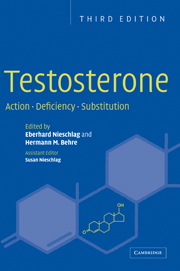Book contents
- Frontmatter
- Contents
- List of contributors
- Preface
- 1 Testosterone: an overview of biosynthesis, transport, metabolism and non-genomic actions
- 2 The androgen receptor: molecular biology
- 3 Androgen receptor: pathophysiology
- 4 Behavioural correlates of testosterone
- 5 The role of testosterone in spermatogenesis
- 6 Androgens and hair: a biological paradox
- 7 Androgens and bone metabolism
- 8 Testosterone effects on the skeletal muscle
- 9 Androgens and erythropoiesis
- 10 Testosterone and cardiovascular diseases
- 11 Testosterone and erection
- 12 Testosterone and the prostate
- 13 Clinical uses of testosterone in hypogonadism and other conditions
- 14 Pharmacology of testosterone preparations
- 15 Androgen therapy in non-gonadal disease
- 16 Androgens in male senescence
- 17 The pathobiology of androgens in women
- 18 Clinical use of 5α-reductase inhibitors
- 19 Dehydroepiandrosterone (DHEA) and androstenedione
- 20 Selective androgen receptor modulators (SARMs)
- 21 Methodology for measuring testosterone, DHT and SHBG in a clinical setting
- 22 Synthesis and pharmacological profiling of new orally active steroidal androgens
- 23 Hormonal male contraception: the essential role of testosterone
- 24 Abuse of androgens and detection of illegal use
- Subject Index
Preface
Published online by Cambridge University Press: 18 January 2010
- Frontmatter
- Contents
- List of contributors
- Preface
- 1 Testosterone: an overview of biosynthesis, transport, metabolism and non-genomic actions
- 2 The androgen receptor: molecular biology
- 3 Androgen receptor: pathophysiology
- 4 Behavioural correlates of testosterone
- 5 The role of testosterone in spermatogenesis
- 6 Androgens and hair: a biological paradox
- 7 Androgens and bone metabolism
- 8 Testosterone effects on the skeletal muscle
- 9 Androgens and erythropoiesis
- 10 Testosterone and cardiovascular diseases
- 11 Testosterone and erection
- 12 Testosterone and the prostate
- 13 Clinical uses of testosterone in hypogonadism and other conditions
- 14 Pharmacology of testosterone preparations
- 15 Androgen therapy in non-gonadal disease
- 16 Androgens in male senescence
- 17 The pathobiology of androgens in women
- 18 Clinical use of 5α-reductase inhibitors
- 19 Dehydroepiandrosterone (DHEA) and androstenedione
- 20 Selective androgen receptor modulators (SARMs)
- 21 Methodology for measuring testosterone, DHT and SHBG in a clinical setting
- 22 Synthesis and pharmacological profiling of new orally active steroidal androgens
- 23 Hormonal male contraception: the essential role of testosterone
- 24 Abuse of androgens and detection of illegal use
- Subject Index
Summary
Testosterone, the hormone that turns males into men, has enjoyed continually growing interest among clinicians and scientists and has gained public attention over the past decades. This heightened interest is matched by a similarly increasing body of research and knowledge about male physiology and testosterone's biological and molecular action, about clinical symptoms and syndromes caused by testosterone deficiency and about the modalities for its use. The number of preparations available for clinical use has also multiplied impressively over recent years.
Proper diagnosis and treatment of testosterone deficiency require a profound understanding of the underlying science. The editors and authors have distilled current knowledge about action, deficiency and substitution of testosterone into this volume which follows two previous editions (1990 and 1998). Commensurate with the expanding knowledge about testosterone the current third edition has grown substantially in volume. Some previous chapters have been completely rewritten, some were combined and condensed in order to make room for new topics.
In order to synchronize the writing of the various chapters the editors and authors met at Castle Elmau in the splendid isolation of the Bavarian Alps at the end of September 2003 for final editing of the manuscripts previously submitted. This guaranteed that all chapters were concluded simultaneously and precisely reflect the current state of knowledge. This coordinated effort of all contributors ensures a long half-life of this book as an up-to-date reference source.
Peter Silver from Cambridge University Press encouraged this book project and we appreciate his help. We wish to thank the authors of the various chapters for their excellent compliance and timely submission of manuscripts.
- Type
- Chapter
- Information
- TestosteroneAction, Deficiency, Substitution, pp. xiii - xivPublisher: Cambridge University PressPrint publication year: 2004

